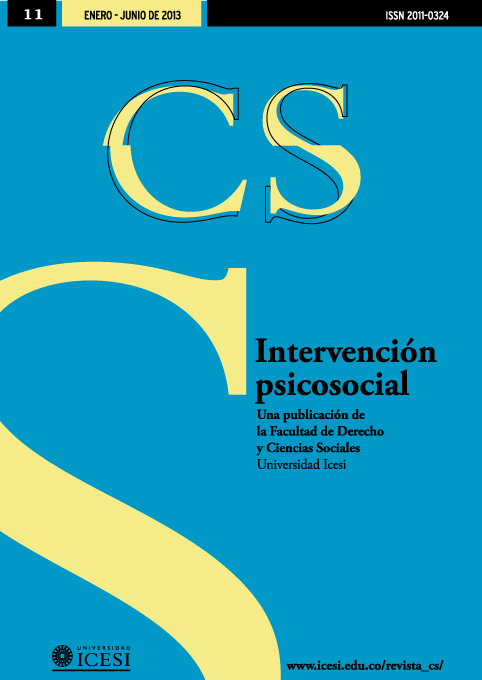Subject, Language, and the Social Organization of Children: Analysis of Discourse
DOI:
https://doi.org/10.18046/recs.i11.1571Keywords:
Primary socialization, school work, analysis of discourseAbstract
The following article presents the results of research on how some mothers discursively refer to children with difficulties in their primary social organizations. Based on surveys and workshops, this study provides an analytical framework supported by the pragmatic view of language and the theory of enunciation to construct a model for the analysis that articulates problems of enunciation, the referent, and speech acts with the indicators of primary social organization. The results of this research take into account the existence of a symbolic framework from which children organize their identity as a social subject.Downloads
References
Austin, J. L. (1982). Cómo hacer cosas con palabras. Barcelona, España: Editorial Paidós.
Bajtin, M. M. (1982). Estética de la Creación Verbal. México D. F., México: Siglo XXI Editores.
Benveniste, E. (1977). Problemas de Lingüística General I. México D. F., México: Siglo XXI Editores.
Bruner, J. (1988). Realidad mental y mundos posibles. Barcelona, España: Gedisa.
Bruner, J. (1991). Actos de significado. Más allá de la revolución cognitiva. Madrid, España: Alianza Editorial.
Bruner, J. (1997). Educación, puerta a la cultura. Madrid, España: Editorial Visor.
Correa, M y Calonje, P. (1995). 'Discurso, conocimiento e interacción en el aula: Un estudio sobre los actos directos e indirectos en el discurso del maestro de primaria', Universidad del Valle.
Correa, M y Orozco, B. C. (1999). 'Intención y conflicto en la escritura de textos narrativos. Un estudio con niños de 8 a 10 años', Universidad del Valle.
Courtés, J. (1997). Análisis semiótico del discurso. Madrid, España: Editorial Gredos.
Eco, H. (1997). Kant y el ornitorrinco. Buenos Aires, Argentina: Lumen.
Gergen, K. J. (1996). Realidades y relaciones. Aproximaciones a la construcción social. Barcelona, España: Paidós.
Gómez Velásquez, G. M. (1996). 'Incidencia del discurso de la madre en la orientación del significado del hijo', Tesis de maestría en lingüística y español, Universidad del Valle.
Greimas, A. J. y Courtés, J. (1990). Semiótica. Diccionario razonado de la teoría del lenguaje. Madrid, España: Gredos.
Lautrey, J. (1985). Clase social, medio familiar e inteligencia. Madrid, España: Visor.
LeVine, R. A. (1988). Comportamiento materno hacia los niños en cinco culturas. En R. A. LeVine, P. M. Miller y M. M. West (Eds.). Parental behavior in diverse societies. San Francisco, USA: Jossey-Bass.
Lozano, J., Peña, C. y Abril, G. (1989). Análisis del discurso. Hacia una semiótica de la interacción textual. Madrid, España: Cátedra S.A.
Prost, A. (1989). Fronteras y espacios de lo privado. En P. Brown, E. Patlagean, M. Rouche, Y. Thébert y P. Veyne (Coord.). Historia de la vida privada. La vida privada en el siglo XX. Vol. 5 (pp. 13-154) Madrid, España: Editorial Taurus.
Sampson, A. (1993). 'La psicología cultural. Reflexiones en torno a Jerome Bruner', Universidad del Valle.
Savater, F. (1997). El valor de educar. Barcelona, España: Editorial Ariel.
Tenorio, M. C. y Orozco, B. C. (1997). 'Pautas y prácticas de crianza en dos comunidades del Valle del Cauca', Universidad del Valle.
Triana, B. (1993). Las teorías implícitas de los padres sobre la infancia y el desarrollo. En M. J. Rodrigo, A. Rodríguez y J. Marrero. Las teorías implícitas. Una aproximación al conocimiento cotidiano. Madrid, España: Visor.
Downloads
Published
Issue
Section
License
Copyright (c) 2013 Jackeline Cantor

This work is licensed under a Creative Commons Attribution-NonCommercial 4.0 International License.
© Reserved Copyright
Material in this publication may be reproduced without authorization, provided the title, author and institutional source is acknowledged.
The content published in Revista CS is distributed under the Creative Commons BY-NC 4.0 Attribution/Recognition-NonCommercial 4.0 International license.
You are free to:
Share — copy and redistribute the material in any medium or format.
Adapt — remix, transform, and build upon the material.
Under the following terms:
Attribution — You must give appropriate credit , provide a link to the license, and indicate if changes were made . You may do so in any reasonable manner, but not in any way that suggests the licensor endorses you or your use.
NonCommercial — You may not use the material for commercial purposes.












